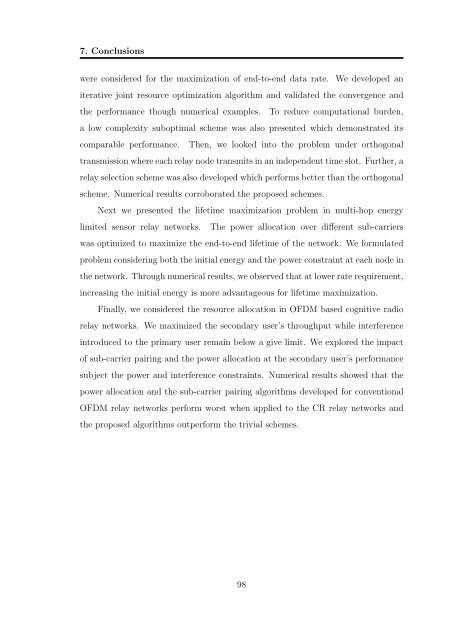Resource Allocation in OFDM Based Wireless Relay Networks ...
Resource Allocation in OFDM Based Wireless Relay Networks ...
Resource Allocation in OFDM Based Wireless Relay Networks ...
You also want an ePaper? Increase the reach of your titles
YUMPU automatically turns print PDFs into web optimized ePapers that Google loves.
7. Conclusions<br />
were considered for the maximization of end-to-end data rate. We developed an<br />
iterative jo<strong>in</strong>t resource optimization algorithm and validated the convergence and<br />
the performance though numerical examples. To reduce computational burden,<br />
a low complexity suboptimal scheme was also presented which demonstrated its<br />
comparable performance. Then, we looked <strong>in</strong>to the problem under orthogonal<br />
transmission where each relay node transmits <strong>in</strong> an <strong>in</strong>dependent time slot. Further, a<br />
relay selection scheme was also developed which performs better than the orthogonal<br />
scheme. Numerical results corroborated the proposed schemes.<br />
Next we presented the lifetime maximization problem <strong>in</strong> multi-hop energy<br />
limited sensor relay networks. The power allocation over different sub-carriers<br />
was optimized to maximize the end-to-end lifetime of the network. We formulated<br />
problem consider<strong>in</strong>g both the <strong>in</strong>itial energy and the power constra<strong>in</strong>t at each node <strong>in</strong><br />
the network. Through numerical results, we observed that at lower rate requirement,<br />
<strong>in</strong>creas<strong>in</strong>g the <strong>in</strong>itial energy is more advantageous for lifetime maximization.<br />
F<strong>in</strong>ally, we considered the resource allocation <strong>in</strong> <strong>OFDM</strong> based cognitive radio<br />
relay networks. We maximized the secondary user’s throughput while <strong>in</strong>terference<br />
<strong>in</strong>troduced to the primary user rema<strong>in</strong> below a give limit. We explored the impact<br />
of sub-carrier pair<strong>in</strong>g and the power allocation at the secondary user’s performance<br />
subject the power and <strong>in</strong>terference constra<strong>in</strong>ts. Numerical results showed that the<br />
power allocation and the sub-carrier pair<strong>in</strong>g algorithms developed for conventional<br />
<strong>OFDM</strong> relay networks perform worst when applied to the CR relay networks and<br />
the proposed algorithms outperform the trivial schemes.<br />
98

















